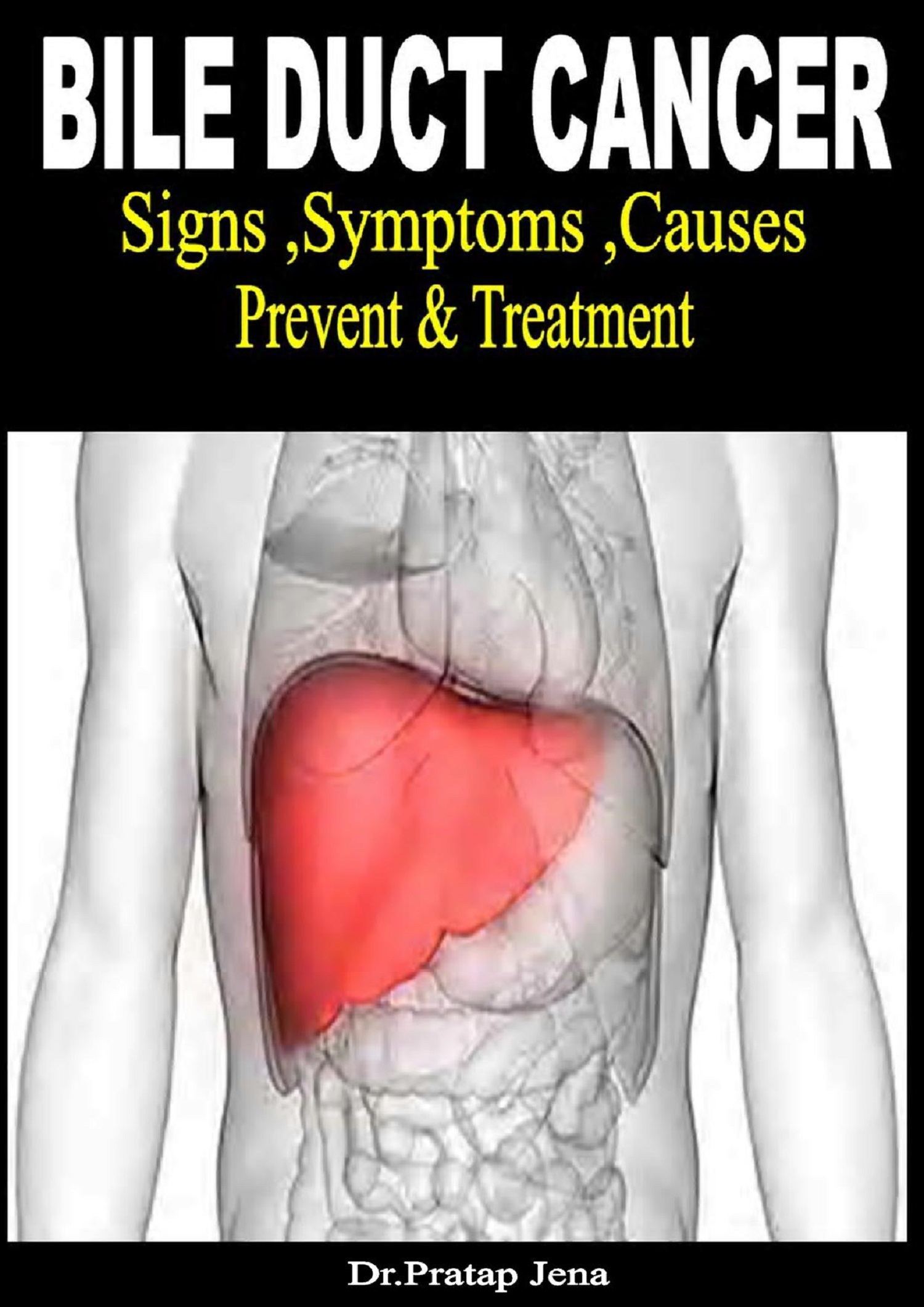
Bile Duct Cancer Signs , Symptoms, Causes ,Prevent & Treatment
On Sale
$3.00
$3.00
Bile Duct Cancer is uncontrolled development of unusual cells (dangerous) that line ducts (tubes) that meet up to shape the hepatic conduits that prompt the gallbladder and are used to move bile from the liver into the gallbladder and in the long run to the small digestive tract. There are two primary composes: intrahepatic (happen in the bile ducts inside the liver) and extrahepatic (happens justified and left bile channels that leave the liver and in the basic bile duct that finishes in the small digestive tract). Cholangiocarcinoma is an uncommon and often fatal cancer that affects the bile ducts.
The bile ducts are a progression of tubes that transport digestive juices called bile from your liver (where it's made) to your gallbladder (where it's stored). From the gallbladder, ducts convey bile to your gut, where it separates fats in the foods you eat.
By and large, cholangiocarcinoma emerges in those parts of the bile ducts that lie outside the liver. Once in a while, the cancer can create in ducts that are located within the liver.
Types of cholangiocarcinoma
Most often, cholangiocarcinomas are part of the group of tumors known as adenocarcinomas, which originate in glandular tissue.
Less regularly, they're squamous cell carcinomas, which create in the squamous cells that line your digestive tract.
Tumors that create outside of your liver tend to be genuinely little. Those in the liver can be little or huge.
•Bile duct growths are generally uncommon.
•Risk factors for bile duct growth may incorporate essential sclerosing cholangitis (fractional or finish bile conduit blockage because of irritation and scarring), ceaseless ulcerative colitis, blisters in the bile channel, and disease with the Chinese liver fluke parasite.
•The two noteworthy indications of bile conduit disease are jaundice and pain in the stomach area, be that as it may, different manifestations may incorporate dim urine, earth shaded stool, irritated skin, fever, unforeseen weight reduction, queasiness, and vomiting.
Diagnosis and arranging of this growth is finished with a blend of liver capacity tests, physical exam and history of the patient, examination of carcinoembryonic antigen (CEA) and CA 19-9 tumormarker test and other test, for example, ultrasound of the stomach area, CTand/or MRI of the mid-region, and MRCP (attractive reverberation cholangiopancreatography). Biopsy tests might be finished with a laparoscope, percutaneous transhepatic cholangiography (PTC), or endoscopic retrograde cholangiopancreatography (ERCP).
•Prognosis and treatment choices rely upon the patient's general therapeutic condition, where the growth happens in the conduit framework, the phase of the malignancy (for instance, where it has spread), and whether the tumor can be expelled by medical procedure.
•This tumor can spread through tissue, the lymph framework, and in the blood.
•Staging of the tumor ranges from organize 0 to arrange IV (arrange IV is partitioned into stages IVA and stage IVB, with arrange IV being the most genuine and stage IVB implies the malignancy has spread to different organs within the body). Intrahepatic and extrahepatic bile channel growths have comparable stages.
•Treatment gets ready for bile channel growth rely on the off chance that it is resectable carefully or unresectable. Treatment designs may incorporate medical procedure, radiation treatment, as well as chemotherapy while some treatment designs use blends of these medications.
•Treatment choices rely upon the person's condition. Different alternatives may incorporate liver transplant as well as interest in clinical preliminaries.
A system of tubes, called channels, interfaces the liver, gallbladder, and small digestive tract. This system starts in the liver where numerous little conduits gather bile (a liquid made by the liver to separate fats amid assimilation). The little conduits meet up to shape the privilege and left hepatic channels, which lead out of the liver. The two ducts join outside the liver and frame the basic hepatic channel. The cystic channel associates the gallbladder to the normal hepatic duct. Bile from the liver goes through the hepatic channels, regular hepatic conduit, and cystic duct and is put away in the gallbladder.
At the point when nourishment is being processed, bile put away in the gallbladder is discharged and goes through the cystic channel to the basic bile conduit and into the small digestive tract.
The bile ducts are a progression of tubes that transport digestive juices called bile from your liver (where it's made) to your gallbladder (where it's stored). From the gallbladder, ducts convey bile to your gut, where it separates fats in the foods you eat.
By and large, cholangiocarcinoma emerges in those parts of the bile ducts that lie outside the liver. Once in a while, the cancer can create in ducts that are located within the liver.
Types of cholangiocarcinoma
Most often, cholangiocarcinomas are part of the group of tumors known as adenocarcinomas, which originate in glandular tissue.
Less regularly, they're squamous cell carcinomas, which create in the squamous cells that line your digestive tract.
Tumors that create outside of your liver tend to be genuinely little. Those in the liver can be little or huge.
•Bile duct growths are generally uncommon.
•Risk factors for bile duct growth may incorporate essential sclerosing cholangitis (fractional or finish bile conduit blockage because of irritation and scarring), ceaseless ulcerative colitis, blisters in the bile channel, and disease with the Chinese liver fluke parasite.
•The two noteworthy indications of bile conduit disease are jaundice and pain in the stomach area, be that as it may, different manifestations may incorporate dim urine, earth shaded stool, irritated skin, fever, unforeseen weight reduction, queasiness, and vomiting.
Diagnosis and arranging of this growth is finished with a blend of liver capacity tests, physical exam and history of the patient, examination of carcinoembryonic antigen (CEA) and CA 19-9 tumormarker test and other test, for example, ultrasound of the stomach area, CTand/or MRI of the mid-region, and MRCP (attractive reverberation cholangiopancreatography). Biopsy tests might be finished with a laparoscope, percutaneous transhepatic cholangiography (PTC), or endoscopic retrograde cholangiopancreatography (ERCP).
•Prognosis and treatment choices rely upon the patient's general therapeutic condition, where the growth happens in the conduit framework, the phase of the malignancy (for instance, where it has spread), and whether the tumor can be expelled by medical procedure.
•This tumor can spread through tissue, the lymph framework, and in the blood.
•Staging of the tumor ranges from organize 0 to arrange IV (arrange IV is partitioned into stages IVA and stage IVB, with arrange IV being the most genuine and stage IVB implies the malignancy has spread to different organs within the body). Intrahepatic and extrahepatic bile channel growths have comparable stages.
•Treatment gets ready for bile channel growth rely on the off chance that it is resectable carefully or unresectable. Treatment designs may incorporate medical procedure, radiation treatment, as well as chemotherapy while some treatment designs use blends of these medications.
•Treatment choices rely upon the person's condition. Different alternatives may incorporate liver transplant as well as interest in clinical preliminaries.
A system of tubes, called channels, interfaces the liver, gallbladder, and small digestive tract. This system starts in the liver where numerous little conduits gather bile (a liquid made by the liver to separate fats amid assimilation). The little conduits meet up to shape the privilege and left hepatic channels, which lead out of the liver. The two ducts join outside the liver and frame the basic hepatic channel. The cystic channel associates the gallbladder to the normal hepatic duct. Bile from the liver goes through the hepatic channels, regular hepatic conduit, and cystic duct and is put away in the gallbladder.
At the point when nourishment is being processed, bile put away in the gallbladder is discharged and goes through the cystic channel to the basic bile conduit and into the small digestive tract.

